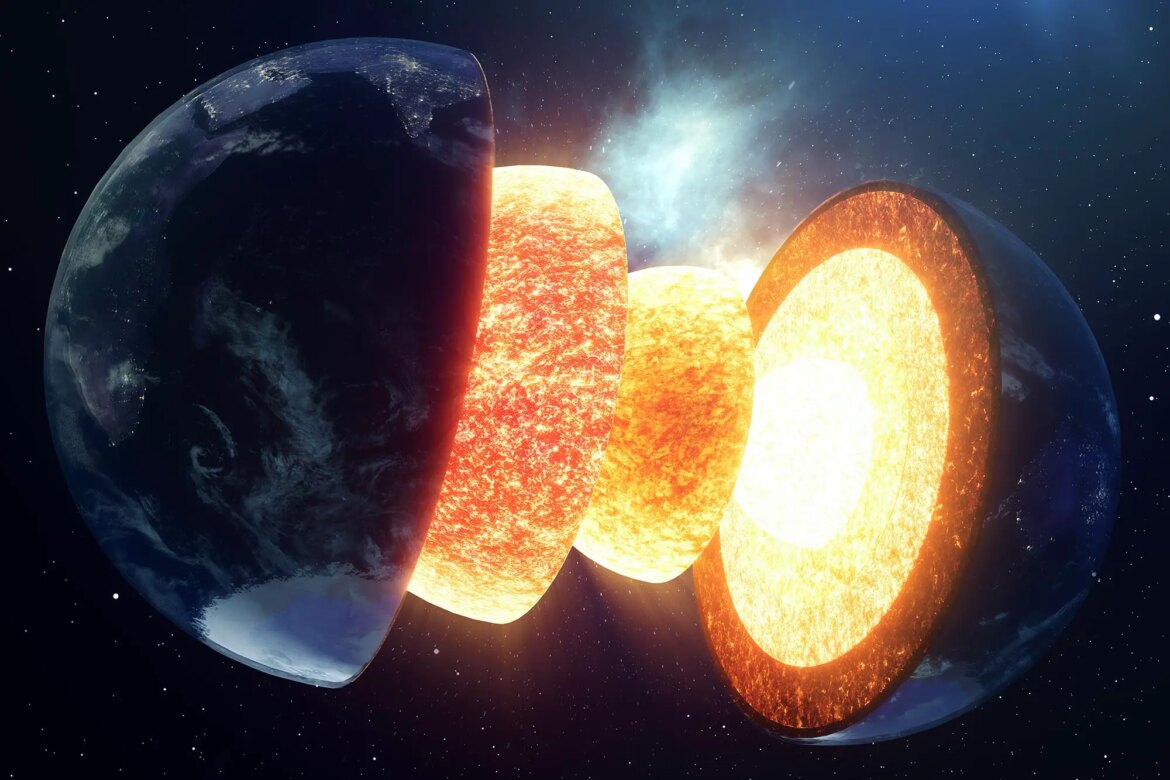Researchers have made an intriguing discovery regarding the Earth’s inner core – it’s not a uniform solid but an elaborate mix of varied materials, like a woven tapestry. This discovery, made by a group from the University of Utah, offers fresh perspectives on Earth’s creation, its evolution, and the establishment of its life-protecting magnetic field.
The study reveals that Earth’s inner core is a complex mix of different elements rather than a homogeneous mass. Their findings, published in the scientific journal Nature, are based on seismic data obtained from earthquakes and the Comprehensive Nuclear-Test-Ban Treaty Organization’s (CTBTO) sensing instruments. The data suggests the inner core expanded quickly initially, slowed down over time, and may even contain trapped liquid iron.
Earth’s center is essentially a solid metal sphere, often described as a “planet within a planet”. The existence of this inner core is integral to life as we know it on the Earth’s surface.
The mystery of how Earth’s inner core formed, expanded, and evolved over time is still being explored by the research team from the University of Utah. Seismic waves from natural earthquakes are the primary tools for this investigation. While the inner core, with its diameter of 2,442 kilometers, makes up less than 1% of Earth’s total volume, it plays a vital role in generating the planet’s magnetic field, thereby shaping Earth’s environment.
Contrary to the previous assumptions made by scientists, the inner core is not a uniform mass but resembles a tapestry of varying elements, explains Guanning Pang, a former doctoral student from the University of Utah’s Department of Geology & Geophysics.
Guanning Pang, now a post-doctoral researcher at Cornell University and lead author of the new study published in Nature, has opened up a new avenue into exploring Earth’s innermost depths.
The research utilized a unique dataset generated by a global network of seismic arrays established to detect nuclear explosions. The dataset was established in 1996 by the United Nations’ CTBTO to enforce the international treaty banning nuclear detonations.
While the main objective of the system is to prevent nuclear detonations, the wealth of data it produces has helped scientists gain a deeper understanding of Earth’s interior, oceans, and atmosphere. It has shed light on events such as meteor blasts, helped identify a colony of pygmy blue whales, enhanced weather prediction, and provided insights into the formation of icebergs.
Exploring Earth’s surface is relatively straightforward; however, studying its interior, unreachable by direct means, poses a significant challenge. Seismic waves generated by earthquakes and travelling through the planet’s crust, mantle, and core are the best available tools for studying this hidden part of our planet.
Keith Koper, a geology professor who heads the University of Utah Seismograph Stations, explains that the formation of the planet involved asteroids colliding and melting, leading to core formation. Heavy metals like iron sank to the center, while lighter liquid rock remained on the outside, eventually freezing over time.
For the last few years, Koper’s lab has been examining seismic data pertaining to the inner core. A previous study led by Pang identified discrepancies between the rotation of Earth and its inner core that may have caused a change in the length of a day between 2001 and 2003.
The new study analyzed seismic data from 20 different seismometer arrays positioned globally. The inner core’s structure was mapped by observing how seismic waves from 2,455 earthquakes, each exceeding magnitude 5.7, bounced off it.
The team believes that their most significant finding is that the heterogeneity of the inner core appears to be more pronounced at deeper levels. “We think this irregularity is linked to how fast the inner core was growing. The inner core grew really quickly a long time ago, reached an equilibrium, and then began to grow much more slowly,” Koper said, suggesting that some liquid iron might still be trapped inside.
Researchers from the University of Southern California, the Université de Nantes in France, and the Los Alamos National Laboratory also contributed to the study, funded by the National Science Foundation.
Reference: “Enhanced inner core fine-scale heterogeneity towards Earth’s centre” by Guanning Pang, Keith D. Koper, Sin-Mei Wu, Wei Wang, Marine Lasbleis and Garrett Euler, 5 July 2023, Nature.
DOI: 10.1038/s41586-023-06213-2
Table of Contents
Frequently Asked Questions (FAQs) about Earth’s inner core
What have the researchers discovered about Earth’s inner core?
Researchers from the University of Utah have found that Earth’s inner core is not a homogeneous mass as previously assumed. Instead, it’s a complex mix of different elements, compared to a woven tapestry.
How was this discovery made?
This discovery was made through the analysis of seismic data obtained from earthquakes and the Comprehensive Nuclear-Test-Ban Treaty Organization’s (CTBTO) sensing instruments.
What is the significance of this research?
The research provides new insights into Earth’s formation, its evolution, and the creation of its protective magnetic field. It enhances our understanding of the inner core’s growth patterns and suggests the possibility of trapped liquid iron within the core.
What does the inner core’s inhomogeneity mean?
The inhomogeneity of the inner core refers to its varied composition. Researchers have found that this irregularity tends to be stronger at deeper levels, implying a more complex structure than previously assumed.
What tools were used to study Earth’s inner core?
The best tools for studying Earth’s inner core are seismic waves generated by earthquakes, which travel through the planet’s crust, mantle, and core, providing data on the core’s structure.
Who participated in this study?
Along with the team from the University of Utah, researchers from the University of Southern California, the Université de Nantes in France, and the Los Alamos National Laboratory also contributed to this study.
Where was this study published?
This study was published in the scientific journal Nature on July 5, 2023.
More about Earth’s inner core
- Nature Journal
- University of Utah
- Comprehensive Nuclear-Test-Ban Treaty Organization
- University of Southern California
- Université de Nantes
- Los Alamos National Laboratory


